Content for TS 23.007 Word version: 19.1.0
1…
2…
4…
5…
6…
10…
11…
12…
14…
15…
15A…
16…
17…
17A…
17B…
17C…
18…
20…
20.3…
21…
22…
25…
27…
28…
31…
31.3…
31.4…
31.6…
22 Downlink Data Notification Handling at MME/S4 SGSN
23 General partial failure handling procedures
24 Restoration of data in the PCRF
24.1 Restart of the PCRF
24.1.0 PCRF Restart
...
...
22 Downlink Data Notification Handling at MME/S4 SGSN |R8| p. 84
If the MME/S4 SGSN receives a Downlink Data Notification message from the SGW as a result of the SGW having received an Error Indication message from the eNodeB/RNC or S4-SGSN over S4 User Plane, the MME/S4 SGSN should perform the following:
- If the UE is in IDLE state, upon receipt of the Downlink Data Notification message, the MME/S4 SGSN shall perform the Network Triggered Service Request procedure as specified in TS 23.060 and TS 23.401.
- If the UE is in CONNECTED state, upon receipt of the Downlink Data Notification message, the MME shall perform S1 Release procedure and perform Network Triggered Service Request procedure as specified in TS 23.401.
- If the UE is in CONNECTED state, upon receipt of the Downlink Data Notification message and Direct Tunnel is used, the S4-SGSN shall perform Iu Release procedure and perform Network Triggered Service Request procedure as specified in TS 23.060 if the cause value included in Downlink Data Notification is "Error Indication received from RNC/eNodeB/S4-SGSN",
- If the UE is in CONNECTED state, upon receipt of the Downlink Data Notification message and Direct Tunnel is not used, the S4-SGSN should re-establish all of the S4-U bearers of this UE if the cause value included in Downlink Data Notification is "Error Indication received from RNC/eNodeB/S4-SGSN".
- If the UE is in IDLE state, the MME shall perform the Network Triggered Service Request procedure as specified in TS 23.401.
- If the UE is in CONNECTED state, the MME may perform an S1 Release procedure and a Network Triggered Service Request procedure as specified in TS 23.401, or as an alternative, the MME may keep the existing S1 signalling connection and just send a Modify Bearer Request message to the SGW to re-establish the S11-U tunnel.
23 General partial failure handling procedures |R9| p. 85
The partial failure handling is an optional feature for MME, SGW, ePDG, TWAN and PGW. Partial failure handling is an optional feature between SGW-C, PGW-C, SGW-U and PGW-U for split SGW and PGW (see TS 23.214).
For split SGW and PGW, the description in this clause related to SGW applies to SGW-C and PGW applies to PGW-C as well.
A partial failure handling feature may be used when a hardware or software failure affects a significant number of PDN connections while a significant number of PDN connections are unaffected. This feature may also be used for the degenerate case of a full/complete failure of a remote node (MME or PGW) in order to cleanup hanging PDN connections associated with the failed node. When it is impossible to recover the affected PDN connections (for example, using implementation-specific session redundancy procedures), it is useful to inform the peer nodes about the affected PDN connections for recovery on the peer nodes. Such a notification could be performed using an identifier that represents a large set of PDN connections rather than on individual PDN connection basis.
For the purposes of partial fault handling the term "node" refers to an entity that takes the role of an MME, PGW, ePDG, TWAN or SGW as defined in an SAE network.
A PDN Connection Set Identifier (CSID) shall identify a set of PDN connections within a node that may belong to an arbitrary number of UEs. A CSID is an opaque parameter local to a node. Each node that supports the feature maintains a local mapping of CSID to its internal resources. When one or more of those resources fail, the corresponding one or more fully qualified CSIDs are signalled to the peer nodes.
The fully qualified CSID (FQ-CSID) is the combination of the node identity and the CSID assigned by the node which together globally identifies a set of PDN connections.
The node identifier shall be globally unique across all 3GPP EPS networks. Its format is defined in TS 29.274
For the purposes of partial fault handling the term peer is used as follows: For a particular PDN connection two nodes are peers if both nodes are used for that PDN connection. For a PDN Connection Set the nodes are peers if they have at least one PDN connection in the PDN Connection Set where both nodes are used for that PDN connection. In particular PGW and MME are generally peers for the purposes of partial fault handling.
An FQ-CSID is established in a node and stored in peer nodes in the PDN connection at the time of PDN connection establishment, or during a node relocation, and used later during partial failure handling in messages defined in TS 29.274 and TS 29.275. Each node that support the feature, including the MME, SGW, ePDG, TWAN and the PGW, shall maintain the FQ-CSID provided by every other peer node for a PDN connection. The FQ-CSIDs stored by PDN connection are later used to find the matching PDN connections when a FQ-CSID is received from a node reporting a partial fault for that FQ-CSID.
With the exception of the GTPv2 Delete PDN Connection Set Request and PMIPv6 Binding Revocation Indication BRI messages, each feature supporting MME, SGW, ePDG, TWAN or PGW shall assign only one FQ-CSID for itself in messages and each FQ-CSID shall have exactly one CSID within the FQ-CSID.
Following rules shall apply for all the nodes:
- If a node (MME, SGW, ePDG, TWAN or PGW) supports the partial failure handling feature, it shall generate and include its own FQ-CSID during the PDN connection establishment, node relocation procedures. Explicit list of the relevant GTPv2 messages is given in the respective clauses (14.3 "Partial Failure Handling at MME", 16.2 "Partial Failure Handling at SGW", 17B.2 "Partial Failure Handling at ePDG", 17C.2 "Partial Failure Handling at TWAN" and 17.2 "Partial Failure Handling at PGW"). A node that supports partial failure handling feature shall also store peers' FQ-CSIDs.
- Additionally, if an SGW supports partial failure handling feature, it shall forward the peer node's (of an MME or of a PGW, depending on the direction) FQ-CSID and also Delete Connection Set Request/Response messages. Also, if the SGW detects the full/complete failure of an MME or PGW, e.g., through the Echo Request/Echo Response procedure, it may send a Delete PDN Connection Set Request (or PMIPv6 Binding Revocation Indication with G bit set) message containing all of the FQ-CSIDs of the associated hanging PDN connections of the failed node to the corresponding remote node (MME or PGW) .
- If a node that supports partial failure handling feature receives peer node's FQ-CSID during the procedures, which are specified in Rule 1, it shall conclude that the peer node supports the feature. Subsequently, the node shall store the peer node's FQ-CSID and shall send appropriate partial failure handling messages to the peer.
- If a node that supports partial failure handling feature does not receive the peer's FQ-CSID during the procedures, which are specified in Rule 1, it shall conclude that the peer node does not support the feature.
- A node that supports partial failure handling feature shall not send any FQ-CSID IE or any partial failure handling specific messages to the peer node if the sender is aware (see Rule 4) that the receiver does not support the feature.
- If a node does not support the partial failure handling feature, it shall ignore any received FQ-CSID IE or any partial failure handling specific message.
- During session management procedures as specified in TS 23.401 and TS 23.402 (such as a dedicated bearer activation/deactivation/update), a node supporting the partial failure handling feature may update its FQ-CSID to the supporting peer node(s) in the Create Bearer Request/Response, Delete Bearer Request/Response or Update Bearer Request/Response.
- If a node (SGW-C, SGW-U, PGW-C or PGW-U) supports the partial failure handling feature, it shall generate and include its own FQ-CSID during the Sx Session Establishment procedure.
- The SGW-C shall initiate Sx Session Modification procedure to update the SGW-U with the MME FQ-CSID, PGW-C FQ-CSID if changed;
- The PGW-C shall initiate Sx Session Modification procedure to update the PGW-U with the MME FQ-CSID, SGW-C FQ-CSID, TWAN FQ-CSID, or ePDG FQ-CSID if changed;
- The SGW-C and the PGW-C may change its FQ-CSID during a Sx Session Modification procedure if its SEID is changed;
- When the node (SGW-C, SGW-U, PGW-C or PGW-U) detects that it has undergone a partial failure, it shall send a Sx Session Set Deletion Request message containing all the its CSIDs of the component(s) failing to its peer node;
- For a SGW-C or a PGW-C, it shall also send Sx Session Set Deletion Request to the SGW-U or PGW-U respectively containing MME FQ-CSID, ePDG FQ-CSID, TWAN FQ-CSID, PGW-C FQ-CSID or SGW-C FQ-CSID if it receives the corresponding GTPv2 message Delete PDN Connection Set Request message containing those FQ-CSID.
- The SGW-C and the PGW-C shall initiate the restoration procedure to restore the Sx Sessions affected by the partial failure in the SGW-U or the PGW-U in the same way as specified in the clause 16.1A.3 for the SGW-U failure and 17.1A.3 for the PGW-U failure respectively, when receiving an Sx Session Set Deletion Request message including a SGW-U or a PGW-U FQ-CSID(s) which is associated with the partial failure from the SGW-U or the PGW-U.
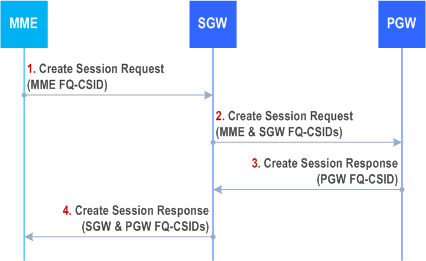
Step 1.
Figure 23-2 illustrates FQ-CSID establishment during the Attach or PDN connection establishment procedures for untrusted non-3GPP access as specified in the above rules.
If an MME supports partial failure handling, the MME shall send own FQ-CSID to SGW with a Create Session Request message across S11 interface.
The MME's FQ-CSID indicates to the SGW that MME supports partial failure handling. If the SGW does not receive MME's FQ-CSID, then the SGW shall never send partial failure handling related messages or IEs to the MME.
If the SGW does not support partial failure handling, then the SGW shall silently discard MME's FQ-CSID.
If the SGW does support partial fault handling it shall store the MME's FQ-CSID in it's PDN connection table.
Step 2.
If the SGW supports partial failure handling, the SGW shall forward MME's FQ-CSID to PGW with a Create Session Request message or a Proxy Binding Update message across S5/S8 interface. The SGW shall also include own FQ-CSID into the message.
The SGW's FQ-CSID indicates to the PGW that the SGW supports partial failure handling.
If the PGW does not support partial failure handling, then the PGW shall silently discard both FQ-CSIDs.
Step 3.
If the SGW has indicated the support for partial failure handling to PGW, then the PGW, which supports the feature shall send own FQ-CSID back to the SGW with a Create Session Response message or a Proxy Binding Acknowledgement message across S5/S8 interface. PGW's FQ-CSIDs in the S5/S8 Create Session Response or a Proxy Binding Acknowledgement message indicates to the SGW that PGW supports partial failure handling.
If the SGW has not indicated support for partial failure handling, then PGW shall never send partial failure handling related messages or IEs to the SGW.
Step 4.
If the MME has indicated the support for partial failure handling to SGW, then the SGW, which supports the feature, shall forward PGW's FQ-CSID to MME with a Create Session Response message across S11 interface. The SGW shall also include own FQ-CSID into the message.
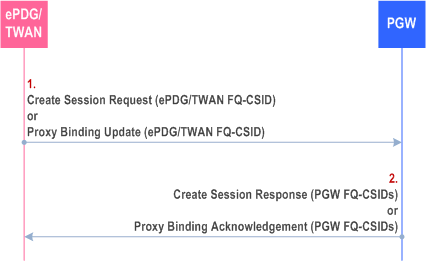
Step 1.
Figure 23-3 illustrates FQ-CSID establishment during the Sx Session Establishment procedure for 3GPP access, with a split SGW, as specified in the above rules.
If an ePDG/TWAN supports partial failure handling, the ePDG/TWAN shall send own FQ-CSID to PGW with a Create Session Request message across GTPv2 based S2b/S2a interface or a Proxy Binding Update message across PMIPv6 based S2b/S2a interface.
The ePDG's/TWAN's FQ-CSID indicates to the PGW that ePDG/TWAN supports partial failure handling. If the PGW does not receive ePDG's/TWAN's FQ-CSID, then the PGW shall never send partial failure handling related messages or IEs to the ePDG/TWAN.
Step 2.
If the PGW supports partial failure handling, it shall store the ePDG's/TWAN's FQ-CSID in its PDN connection table and it shall send own FQ-CSID back to the ePDG/TWAN with a Create Session Response message across GTPv2 based S2b/S2a interface or a Proxy Binding Acknowledgement message across PMIPv6 based S2b/S2a interface. PGW's FQ-CSIDs in the Create Session Response or Proxy Binding Acknowledgement indicates to the ePDG/TWAN that PGW supports partial failure handling. The ePDG/TWAN shall then store the PGW's FQ-CSID in its PDN connection table.
If the PGW does not support partial failure handling, then the PGW shall silently discard ePDG's/TWAN's FQ-CSID.
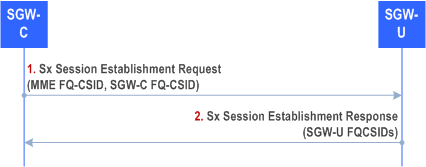
Step 1.
Figure 23-4 illustrates FQ-CSID establishment during the Sx session Establishment procedure with a split PGW as specified in the above rules.
If an SGW-C supports partial failure handling, the SGW-C shall send its own FQ-CSID and MME FQ-CSID to the SGW-U in the Sx Session Establishment Request.
Step 2.
If the SGW-U supports partial failure handling, it shall store the SGW-C FQ-CSID and MME FQ-CSID for the related Sx Session and it shall send its own FQ-CSID back to the SGW-C in the Sx Session Establishment Response message. The SGW-U's FQ-CSID in the Create Session Establishment Response implicitly indicates to the SGW-C that SGW-U supports partial failure handling. The SGW-C shall then store the SGW-U's FQ-CSID for the related Sx Session. If the SGW-C does not receive an SGW-U FQ-CSID from the SGW-U, then the SGW-C shall not further send partial failure handling related messages or IEs to the SGW-U.
If the SGW-U does not support partial failure handling, then the SGW-U shall silently discard the SGW-C's FQ-CSID and MME FQ-CSID.
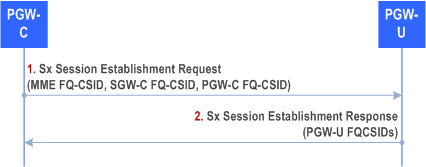
Step 1.
Figure 23-5 illustrates FQ-CSID establishment during the Sx Session Establishment procedures to provide the PGW-C FQ-CSID to the SGW-U after receiving a PGW-C FQ-CSID in Create Session Response from PGW-C on the S5/S8 interface.
If a PGW-C supports partial failure handling, the PGW-C shall send its own FQ-CSID, SGW-C FQ-CSID, TWAN FQ-CSID, ePDG FQ-CSID and MME FQ-CSID to PGW-U in the Sx Session Establishment Request.
Step 2.
If the PGW-U supports partial failure handling, it shall store the PGW-C FQ-CSID, SGW-C FQ-CSID, TWAN FQ-CSID, ePDG FQ-CSID and MME FQ-CSID for the related Sx Session and it shall send its own FQ-CSID back to the PGW-C in the Sx Session Establishment Response message. The PGW-U's FQ-CSIDs in the Sx Session Establishment Response implicitly indicates to the PGW-C that PGW-U supports partial failure handling. The PGW-C shall then store the PGW-U's FQ-CSID for the related Sx Session. If the PGW-C does not receive a PGW-U FQ-CSID from the PGW-U, then the PGW-C shall not further send partial failure handling related messages or IEs to the PGW-U.
If the PGW-U does not support partial failure handling, then the PGW-U shall silently discard PGW-C's FQ-CSID.
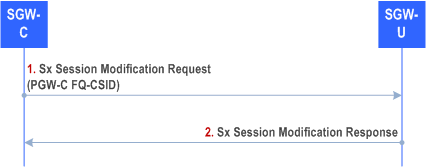
Step 1.
If an SGW-C supports partial failure handling and the SGW-U has indicated its support of partial failure in the Sx Session Establishment Response, the SGW-C shall send PGW-C FQ-CSID received on S5/S8 interface to the SGW-U in an Sx Session Modification Request.
Step 2.
If the SGW-U supports partial failure handling, it shall store the PGW-C FQ-CSID for the related Sx Session and send a reply to the SGW-C.
If the SGW-U does not support partial failure handling, then the SGW-U shall silently discard the PGW-C's FQ-CSID.
24 Restoration of data in the PCRF |R10| p. 90
24.1 Restart of the PCRF p. 90
24.1.0 PCRF Restart p. 90
PCRF storage of PCC contexts is volatile. When a PCRF fails, the PCC contexts and Diameter sessions affected by the failure are lost in the PCRF.
When a PCRF receives a non-initial message for which no Diameter session exists, it shall discard the message and return a Diameter error indication to the originating PCRF client.